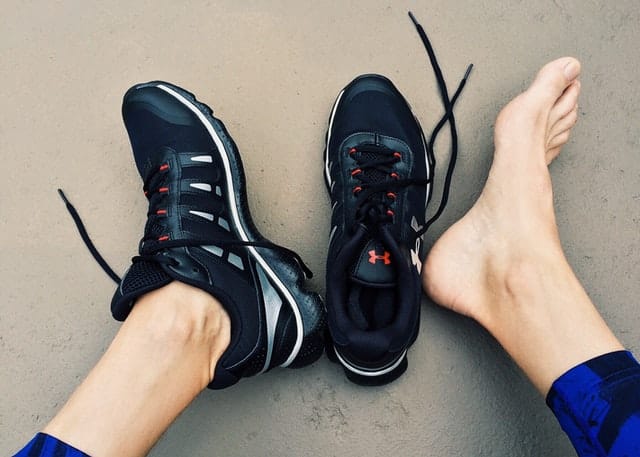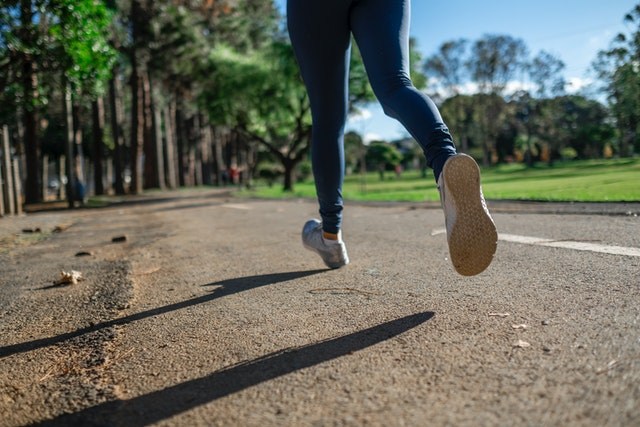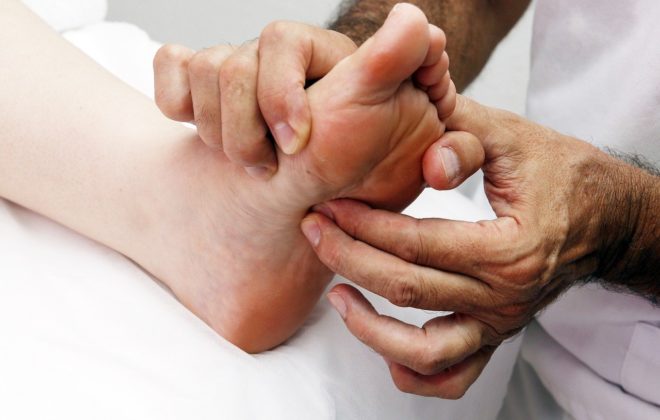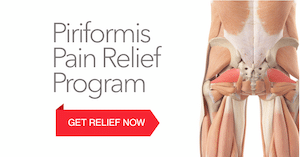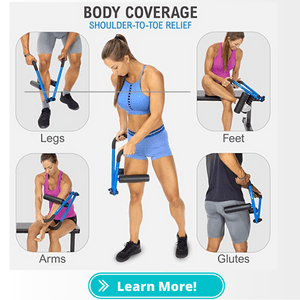Plantar Fasciitis Exercises – Pain Relief + Improve Flexibility
Recently I did a complete search of plantar fasciitis exercises, and the initial few search result pages produced some classic but very limited options.
If you have a super simple or mild case of Plantar fasciitis that is easily fixable, these general movements will help and you may not need anything fancy.
However, many people with chronic plantar fasciitis will have a different story, and likely require a more precise step-by-step progression of exercises AND stretches, along with knowing which plantar fasciitis exercises to avoid.
For example, a common recommendation is to perform calf raises. The problem here is that many people can’t perform this exercise with 100% of their bodyweight without really irritating the already inflamed plantar fascia.
Sure, you could probably just “power through” it, but I certainly don’t recommend it, especially when there are many options to start exercises and stretching, then graduate into the more challenging ones without putting yourself into more pain.
Best Plantar Fasciitis Stretches
One of the most common therapeutic recommendations for treating plantar fasciitis is stretching. This is predominately because the evidence shows most individuals dealing with plantar fasciitis have reduced dorsiflexion of the ankle. Reduced motion of the ankle leads to alteration in weight bearing in the foot, putting more strain on the plantar tissue.
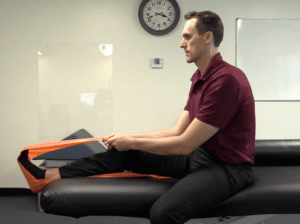
When implemented consistently over the short term (about 3 months), research supports significant improvement in symptoms especially when both calf and plantar fascia stretches are combined, but over the long run, is about equal when compared to plantar fasciitis exercises.
Below I have compiled my go-to plantar fasciitis stretches. They are ordered generally in intensity, and I often assign my personal clients 2-3 at a time along with self massage work, which can be helpful in reducing plantar fascia trigger points.
NOTE: Always consult with your healthcare provider before doing any new stretching program, because sometimes heel pain is not plantar fasciitis!
Big Toe | First MTP Joint Stretch
Seated Calf Stretch With Band Or Towel + Big Toe Focus
Big Toe | 1st MTP Quadruped Stretch
Seated Calf Stretch With Band Or Towel
Standing Calf Stretch
How much and how often should stretches be performed?
As with most everything in the exercise + therapy realm, there is debate on the most effective way to perform plantar fasciitis stretches and exercises.
Various research papers show there doesn’t seem to be any clear winner universally.
Therefore, my recommendation for personal clients is to perform 3 repetitions, holding for the standard 20-30 seconds each. Intensity on a 1-10 (10 being most intense), I do not recommend going more than a 5 when it comes to intensity.
The goal is to alleviate discomfort, introduce stretch to the tissues, and avoid any flare-ups due to being too aggressive.
A minimum of 2x per day works best, and if the intensity is kept low, they can be performed more often.
Best Plantar Fasciitis Exercises
The exercises below are outlined based on 3 categories:
- The muscles of the foot (called intrinsic muscles).
- The calf muscles + achilles tendon (both always involved with plantar fasciitis)
- Combo of the above 2
In addition, I have also sorted the exercises into versions that include a stretch of the calf and ankle, and versions that do not. The reason I did this is because some people can’t tolerate much lengthening due to either irritation of the tissues (achilles for example), OR some orthopedic restriction of the ankle.
Either way, as long as the exercises are progressed over time, it appears both versions will produce a good result. I do want to note, however, that reduced ankle range of motion and calf flexibility is one of the factors that is thought to contribute to plantar fasciitis, so stretching may need to be added into the program at some point if you don’t tolerate the stretch versions of the exercises.
This decision should be left to you + your health provider or therapist to figure out what is best for you.
Exercises that Focus on the Intrinsic Foot Muscles
Foot Intrinsic Exercise With Towel
This simple exercise, often referred to as the “towel scrunch” with a washcloth, targets the toe muscles specifically.
To perform this exercise:
- Use a medium-sized towel and place it on the floor. Place your heel on the edge of the towel near you.
- Spread your toes and try to reach out and grab the towel and curl your toes toward you.
- Repeat for as many repetitions as possible before needing to reset the towel.
- This exercise can be repeated multiple times per day.
Standing Band Toe Flexion Exercise
This exercise targets toe flexion to improve mobility and also strengthen the intrinsic muscles of the foot.
To perform this exercise:
- Use a light exercise band to start with. Stand with your foot on the middle of the band.
- Pull tension upward on the band until you reach the desired amount of resistance.
- While keeping the whole foot in contact with the ground, press the toes down toward the floor.
- Repetition range can vary, but 15-20 is average, performed multiple times per day.
Exercises that Focus on the Tibialis Anterior Muscle
Seated Foot + Ankle Dorsiflexion
This exercise targets the muscles that dorsiflex the foot and ankle, predominately the tibialis anterior.
To perform this exercise:
- While sitting, place a pillow or foam roller under your knees and foot hanging over the side of the table/bed. This does not affect the performance of the muscle activity, but allows for positional comfort, especially if you have tight hamstrings, sciatic tension, or lower back discomfort.
- Initiate the movement by pulling your toes up toward your knees. You will feel the muscles on the front of your shin, but also a slight stretch in the calf + achilles area.
- Repeat for repetitions until light fatigue (usually 20-30), and this movement can be performed multiple times per day.
Seated Foot + Ankle Dorsiflexion with Band
This exercise is the same as previous, with the addition of a band for resistance. The band can be tied around something that is secure and allows for appropriate resistance to get 20-30 repetitions.
Exercises that Focus on the Calf Muscles + Achilles Tendon
Without Stretch
Seated Single Leg Calf Press With Band – Eccentric Only
Eccentric-only exercises have become popular for tendon-based rehabilitation. The eccentric portion of a movement is essentially the lowering-phase.
By reducing the tension on the band during the lifting phase (concentric), pure eccentric training can be accomplished to strengthen the tendons and plantar fascia.
To perform this exercise:
- Start by sitting with one leg straight or near straight (pillow or bolster under knee if needed).
- Place the band around the foot.
- Pull tension in the band toward you as you resist the tension with your foot until you reach the desired range of motion.
- Let go of the band tension, then return your foot back to the starting position.
- Recommended repetition ranges can vary, but generally 10-15 repetitions are performed, 1-2 sets, working up to multiple times per day.
Seated Calf Press With Band
This exercise is performed the same was as the previous, but full range of motion is used. This is a favorite starting exercise for strengthening because the resistance can be easily modified for pain-free training.
Repetitions can vary highly for this exercise, but generally 15-20 is the standard, performed multiple times per day.
Supported Calf Raise
There is often difficulty bridging the gap between the seated and standing versions of calf raises. In therapy or gym settings, this gap can be filled with exercise machines such as a calf press or seated calf machine, but these aren’t always available for many people.
The supported calf raise can be a good option. By resting the elbows and upper body on a counter top or equivalent, the weight on the lower extremity can be reduced by quite a bit.
To perform this exercise:
- Start by locating a surface approximately mid-thigh level or higher.
- Bend forward at the hips and rest your upper body on the surface.
- While keeping the knees just slightly bent, press your toes into the ground and perform a full calf raise.
- Hold briefly, then return to the start.
- Repeat until light fatigue or roughly between 15-20 repetitions, and work up to multiple times per day.
Supported Single Leg Calf Raise – Eccentric Only
This exercise is performed in a similar was as the previous, but this version is eccentric only on single leg.
To perform this exercise:
- Start in the same position as the previous.
- Shift your weight to the NON-affected side (so if you have plantar fasciitis on the left foot for example you would shift your weight to the right foot).
- Perform the calf raise.
- At the top of the movement, shift your weight to the affected side (in this example the left side)
- Lower down until control.
- Shift the weight back to the unaffected side and repeat.
- As with most eccentric training recommendations, this is performed generally for 10-15 repetitions, working up to multiple times per day.
Supported Single Leg Calf Raise
This exercise is performed in the same way as the previous, but with both the concentric and eccentric portions included.
General recommendation is to perform until light fatigue or 15-20 repetitions, working up to multiple times per day.
Standing Calf Raise
The standing calf raise is the standard for strengthening the muscles of the lower legs. It is performed in the same fashion as the previous exercises, but with upright body alignment.
I recommend placing fingers on a countertop or wall to reduce focus on balancing as the calf raise is performed.
Standing Single Leg Calf Raise – Eccentric Only
This version of the standing calf raise is focused on eccentric training only. It is a also a great bridge to the single leg calf raise with full range of motion.
To perform this exercise:
- Start in the same position as the previous.
- Shift your weight to the NON-affected side (so if you have plantar fasciitis on the left foot for example you would shift your weight to the right foot).
- Perform the calf raise.
- At the top of the movement, shift your weight to the affected side (in this example the left side)
- Lower down until control.
- Shift the weight back to the unaffected side and repeat.
- As with most eccentric training recommendations, this is performed generally for 10-15 repetitions, working up to multiple times per day.
Standing Single Leg Calf Raise
The standing single leg calf raise is performed in the same fashion as the previous, but with performing both concentric and eccentric portions of the movement.
Generally, I find that a target of working up to 15 repetitions on each side is a sufficient level of strength on this exercise. Due to the increased loading on this exercise, I often only recommend it once per day in order to avoid muscular soreness which can prevent daily training.
With Stretch
As above, the exercises below are the same as above, with the exception of adding the stretch component off a step. I have included links to the Youtube clips for your convenience. These will open in a new tab.
Supported Calf Raise – Lower To Stretch
Supported Single Leg Calf Raise – Eccentric Only – Lower To Stretch
Standing Single Leg Calf Raise
Exercises that Combine Intrinsic Foot + Calf Muscles + Achilles Tendon
The exercises in this section are aimed at all 3 areas: the intrinsic foot muscles, calves, and achilles. This can be simply accomplished with elevating the toes on a small towel roll to increase starting tension on the plantar fascia.
Its important to note that in some people this can be a strong increase in intensity, and even if you have progressed through the previous series of exercises, you may need to take a few steps back in progressions in order to initiate the toe elevated versions.
As always, connect with your therapist before adding them in to see which is the best approach for you.
All of these movements are assigned with the same repetitions/frequency recommendations mentioned previously relative to the same body positioning.
Without Stretch
Supported Calf Raise – Toe Elevated
Supported Single Leg Calf Raise – Toe Elevated
Standing Calf Raise – Toe Elevated
Standing Single Leg Calf Raise – Eccentric Only – Toe Elevated
With Stretch
As above, the exercises below are the same as above, with the exception of adding the stretch component off a step. I have included links to the Youtube clips for your convenience. These will open in a new tab.
Supported Calf Raise – Toe Elevated – Lower To Stretch
Supported Single Leg Calf Raise – Eccentric Only – Toe Elevated – Lower To Stretch
Standing Calf Raise – Toe Elevated – Lower To Stretch
Standing Single Leg Calf Raise – Toe Elevated – Lower To Stretch
When to Progress Exercises
A common question that arises is “How do I know when to progress to the next exercise?”
In my personal practice, when working with clients, I generally recommend spending a week with an exercise with no flare ups the next day before attempting the next progression.
I may include a few variables to work on, which could include hitting a certain number of repetitions, sets, or times per day as well, but it all depends on the individual’s needs and response, and of course how long they have been dealing with chronic plantar fascia pain.
When moving forward to the next progression, I also recommend only adding it in every OTHER day until adaptation occurs, then it can be progressed to daily.
The factors that will affect progression with plantar fasciitis exercises can include:
- Load (amount of resistance or weight)
- Range of motion
- Repetitions
- Sets
- Speed of movement
- Number of times performed per day
All of these factors can be manipulated in order to increase/decrease stress on the tissues and allow for adaptation without triggering unwanted flare ups.
Just remember, exercises alone won’t help you overcome plantar fasciitis. Stretching, massage therapy, and other therapeutic modalities such as self massage for plantar fasciitis combined often work to get the best results. Trigger point therapy for plantar fasciitis may be very helpful as well.
Here are some quick important stats on triggers for Plantar Fasciitis that effect recommendations:
- Approximately 10% of all injuries in connection with running deal with PF (Impact)
- Obesity is an issue for PF in 70% of cases (Prolonged pressure)
- Not changing footwear (Either prolonged pressure and/or stretch on tissues)
- Standing all day (Prolonged pressure)
- Age 40-60 has highest occurrence of plantar fasciitis (Age is associated with lack of tissue elasticity)
- Movement mechanics/limitations in lower extremity which contributes to the pattern that triggered it to begin with.
Do You Have To Stop Exercising?
In general, no, you do not have to stop exercising when you’re dealing with plantar fasciitis, but you do need to MODIFY what you’re doing to work around the painful area.
I often see people that stop doing literally everything when they get a flare up. I think this is a big mistake, as it can lead to loss of fitness and for some people, more mental/emotional stress, as exercise their preferred form of stress relief.
There is a lot that you can do to stay fit and active that won’t flare up pain in your feet.
Here are a great list of gym exercises you can do that don’t involve the foot:
- Leg Extensions
- Leg Curls
- Seated Hip Abductions + Adductions
- Lat Pulldowns
- Bench Press
- Shoulder Press
- Abdominal Crunches
- Rear Delt Flyes
- Bicep Curls
- Tricep Press-downs
Obviously there are many more options than these!
Exercises To Avoid With Plantar Fasciitis
Movements that tend to be most aggravating when the plantar fascia tissues are irritated involve impact and speed.
Some of these might include:
- Plyometrics (jumping)
- Sports that involve speed and/or quick changes of direction (almost all of them!)
- Running
- Aggressive training for the lower leg (this is relative to the fitness level of the individual)
When it comes to specific exercises for the calves and feet, you need to seek the advice of your doctor or therapist. Depending on the initial type of injury, where you are at in the injury cycle, and amount of pain you’re experiencing, they will help you determine the best progressions of plantar fasciitis exercises to start with.
Is It Safe To Exercise?
In general, for most people, it appears exercising is ok for plantar fasciitis under the care of a therapist or physician after ruling out any potential underlying pathology. Stretching is also a good idea as well as reducing trigger points in the surrounding muscles.
How To Modify Cardiovascular Exercise
One of the challenges with plantar fasciitis is how to stay active enough to lose weight, which is one of the long-term health factors to address.
Walking is the go-to exercise for most people to stay active, but it can really irritate an active flare up. When advising my personal clients in these cases, I recommend pool-based exercise above all.
The combination of reduced weight and minimal impact is the perfect combination for getting in a high volume of movement.
Some people prefer to use the elliptical (if tolerated) and others can use the stationary bike or rower.
Of course these options all depend on the person. I have had people that could only tolerate swimming initially.
References For Plantar Fasciitis Exercises:
- https://factsandphysio.com/plantar-fasciitis/
- https://www.aafp.org/pubs/afp/issues/2019/0615/p744.html
- https://www.painscience.com/tutorials/plantar-fasciitis.php
- https://www.hmpgloballearningnetwork.com/site/podiatry/what-research-reveals-about-stretching-and-plantar-fasciitis
Sam Visnic
Most Popular Posts
Categories
- Deep Gluteal Pain Syndrome (8)
- Deltoids (2)
- Foam Rolling (2)
- Glutes (9)
- Hamstrings (5)
- Hypnosis for Pain (3)
- Lats (2)
- Levator Scapulae (4)
- Lifestyle (8)
- Massage Therapy (39)
- Mobility (21)
- Movement and Exercise (19)
- Muscles (22)
- Nutrition (2)
- Obliques (1)
- Pain (25)
- Pectorals (3)
- Piriformis (3)
- Plantar Fasciitis (11)
- Psoas (11)
- Quadratus Lumborum (3)
- Quadriceps (2)
- Rhomboids (3)
- Sciatica (1)
- Serratus Anterior (1)
- SI Joint (14)
- Sternocleidomastoid (1)
- Stretching (18)
- Subscapularis (1)
- TMJ (2)
- Trapezius (1)
- Uncategorized (13)

